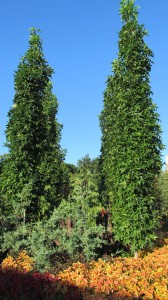Sweetgum (Liquidambar styraciflua) is a medium to large landscape tree, which matures to 65-70 feet in height and 35 feet in spread. To many people it’s called the cursed “gumball” or “ankle twister” tree, not be confused with the fruit balls of the American sycamore or London plane tree (Platanus spp.).
Gumball detractors should look at ‘Slender Silhouette’ sweetgum which produces very few, if any, fruit. ‘Slender Silhouette’ matures to 45-50 feet in height and 12-15 feet in width. Growth rate is rapid at 2-3 feet per year. The cultivar imposes a decidedly vertical architecture to the landscape. The tree’s narrow form makes it a good fit for smaller properties either utilized as a specimen tree or as a tall hedge (green privacy fence).
Foliage is glossy dark green through the spring and summer months. Fall color, which is varies by location and soil pH, ranges from yellow, orange, red, and burgundy. Leaves are 3-5 inches broad with 5, sometimes 7, star-shaped pointed lobes.
Sweetgum is native to USDA zones 5-8, and thrives in the Southern Appalachian region (USDA zones 6 and 7). Bark is light brown and young twigs and branches often form scaly ridges similar to burning bush (Euonymus alata ‘Compacta’).
Landscapers often prefer planting sweetgum over maples (Acer spp.) and ashes (Fraxinus spp.) for its forgiving nature regarding soil type, including on marginally drained clay sites. Sweetgum is not dependable as a street tree where roots may be restricted.


 Posted in
Posted in 
